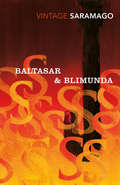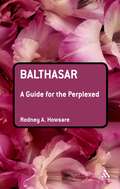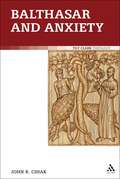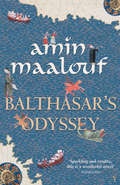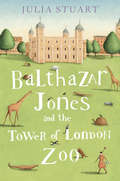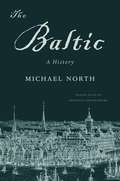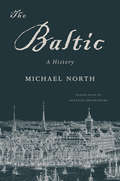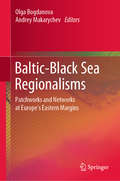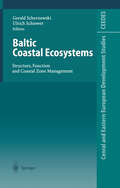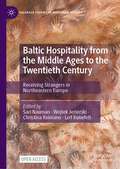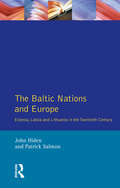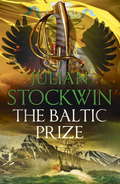- Table View
- List View
Baltasar & Blimunda
by José SaramagoIn early eighteenth-century Lisbon, Baltasar, a soldier who has lost his left hand in battle, falls in love with Blimunda, a young girl with visionary powers. From the day that he follows her home from the auto-da-fe where women are burned at the stake, the two are bound body and soul by love of an unassailable strength. A third party shares their supper that evening: Padre Bartolomeu Lourenco, whose fantasy is to invent a flying machine. As the Crown and the Church clash, they purse his impossible, not to mention heretical, dream of flight.
Balthasar: A Guide For The Perplexed (Guides for the Perplexed #198)
by Rodney HowsareIn Balthasar: A Guide for the Perplexed, Rodney Howsare gives the reader a handle on these perplexing aspects of Balthasar's thought. In the first chapter he introduces the reader to the man and his unique method of doing theology. He then moves on to explaining the basic structure and nature of Balthasar's trilogy: the aesthetics, dramatics, and logic. He then deals with various theological topics: Jesus Christ, The Trinity, The Drama of Redemption, The Church and Mary, and The Last Things. A final chapter summarizes Balthasar's place in modern theology and suggests further readings for the interested reader.
Balthasar and Anxiety
by John R. CihakThis study offers a theological response to the problem of anxiety from the point of view of Hans Urs von Balthasar. It is a systematic presentation, analysis and development of Balthasar's original theology of anxiety found in his only work on the subject, Der Christ und die Angst. The study takes a thematic approach based upon the four types of analysis found in Der Christ und die Angst: phenomenological, anthropological, theological and ecclesial. These four approaches to the topic correspond to the phenomenon, origins, redemption and transformation of anxiety. Through this thematic approach, Balthasar's thought is examined in relation to some of the important figures on anxiety. The phenomenon of anxiety is presented in relation to modern psychiatry. The examination of anxiety's origins places him in dialogue with Kierkegaard on anxiety from discursive reasoning and Freud on anxiety from ego-consciousness. The redemption of anxiety places Balthasar in relation to Aquinas in order to clarify Balthasar's interpretation and to show its significance in the theological tradition. The transformation of anxiety places our author in dialogue with Luther on the shape of anxiety in the Christian life. The final chapter begins to unravel the construct of anxiety, with a brief exploration of how it is transformed in the Church according to Balthasar, something he had never explicitly developed. The influence of Bernanos on Balthasar's thought is felt throughout the study. The entire study is framed by the two Gardens wherein transpire the most significant events concerning anxiety for Balthasar: the Garden of Eden and the Garden of Gethsemane.
Balthasar and Anxiety (T And T Clark Theology Ser.)
by John R. CihakThis study offers a theological response to the problem of anxiety from the point of view of Hans Urs von Balthasar. It is a systematic presentation, analysis and development of Balthasar's original theology of anxiety found in his only work on the subject, Der Christ und die Angst. The study takes a thematic approach based upon the four types of analysis found in Der Christ und die Angst: phenomenological, anthropological, theological and ecclesial. These four approaches to the topic correspond to the phenomenon, origins, redemption and transformation of anxiety. Through this thematic approach, Balthasar's thought is examined in relation to some of the important figures on anxiety. The phenomenon of anxiety is presented in relation to modern psychiatry. The examination of anxiety's origins places him in dialogue with Kierkegaard on anxiety from discursive reasoning and Freud on anxiety from ego-consciousness. The redemption of anxiety places Balthasar in relation to Aquinas in order to clarify Balthasar's interpretation and to show its significance in the theological tradition. The transformation of anxiety places our author in dialogue with Luther on the shape of anxiety in the Christian life. The final chapter begins to unravel the construct of anxiety, with a brief exploration of how it is transformed in the Church according to Balthasar, something he had never explicitly developed. The influence of Bernanos on Balthasar's thought is felt throughout the study. The entire study is framed by the two Gardens wherein transpire the most significant events concerning anxiety for Balthasar: the Garden of Eden and the Garden of Gethsemane.
Balthasar on the Spiritual Senses: Perceiving Splendour (Changing Paradigms in Historical and Systematic Theology)
by Mark McInroyIn this study, Mark McInroy argues that the 'spiritual senses' play a crucial yet previously unappreciated role in the theological aesthetics of Hans Urs von Balthasar. The doctrine of the spiritual senses typically claims that human beings can be made capable of perceiving non-corporeal, 'spiritual' realities. After a lengthy period of disuse, Balthasar recovers the doctrine in the mid-twentieth century and articulates it afresh in his theological aesthetics. At the heart of this project stands the task of perceiving the absolute beauty of the divine form through which God is revealed to human beings. Although extensive scholarly attention has focused on Balthasar's understanding of revelation, beauty, and form, what remains curiously under-studied is his model of the perceptual faculties through which one beholds the form that God reveals. McInroy claims that Balthasar draws upon the tradition of the spiritual senses in order to develop the means through which one perceives the 'splendour' of divine revelation. McInroy further argues that, in playing this role, the spiritual senses function as an indispensable component of Balthasar's unique, aesthetic resolution to the high-profile debates in modern Catholic theology between Neo-Scholastic theologians and their opponents. As a third option between Neo-Scholastic 'extrinsicism', which arguably insists on the authority of revelation to the point of disaffecting the human being, and 'immanentism', which reduces God's revelation to human categories in the name of relevance, McInroy proposes that Balthasar's model of spiritual perception allows one to be both delighted and astounded by the glory of God's revelation.
Balthasar's Odyssey: A Novel
by Amin MaaloufThere are ninety-nine names for God in the Koran, is it possible that there is a secret one-hundredth name? In this tale of magic and mystery, of love and danger, Balthasar's ultimate quest is to find the secret that could save the world. Before the dawn of the apocalyptic 'Year of the Beast' in 1666, Balthasar Embriaco, a Genoese Levantine merchant, sets out on an adventure that will take him across the breadth of the civilised world, from Constantinople, through the Mediterranean, to London shortly before the Great Fire. Balthasar's urgent quest is to track down a copy of one of the rarest and most coveted books ever printed, a volume called 'The Hundredth Name', its contents are thought to be of vital importance to the future of the world. There are ninety-nine names for God in the Koran, and merely to know this most secret hundredth name will, Balthasar believes, ensure his salvation.
Balthasar's Trilogy (Reader's Guides)
by Stephen WigleyThis book is an undergraduate introduction to one of the most important works of 20th-century Catholic theology.
Balthazar: The Alexandria Quartet (volume Two) (The\alexandria Quartet Ser. #2)
by Lawrence DurrellLose yourself in the thrilling political intrigue and tangled love affairs of wartime Egypt, in Durrell's epic modern classic.Every interpretation of reality is based upon a unique position ...As the threat of war looms over Alexandria, an exiled Anglo-Irish schoolteacher unravels his erotic obsession with two women: Melissa, a dancer, and Justine, a glamorous Egyptian wife. During sessions with his psychiatrist, Balthazar, their intricate love affair is cast in a radical, sinister new light, illuminating a mysterious plot connected to a recent murder - but Lawrence Durrell's kaleidoscopic storytelling means that nothing is ever as it seems ... 'Legendary ... Casts a spell ... A fine storyteller. Reader, watch out!' Jan Morris, Guardian'A brave and brazen work ... Lush and grandiose.' Independent 'One of the very best novelists of our time ... [such] beauty.' New York Times Book ReviewVOLUME TWO OF LAWRENCE DURRELL'S ALEXANDRIA QUARTET
Balthazar Jones and the Tower of London Zoo
by Julia StuartA poignant, magical and completely original novel that you can’t fail to love, for fans of Joanne Harris.
The Baltic: A Regional Future?
by John FitzmauriceThis book examines the historical, political, cultural and economic links between the littoral states of the Baltic sea and seeks to analyse what it is that has created a strong sense of regional identity within the area, that has enabled the area to survive conflicts external to the region that have been projected onto the region. Thus, this sense of identity now forms the basis for future regional cooperation that could be a significant factor for stability in the region.
The Baltic: A History
by Michael NorthFrom the Vikings to the EU the Baltic has been a Nordic Mediterranean, a shared maritime zone with distinct patterns of trade, cultural exchange, and conflict. Covering a thousand years in a part of the globe where seas are more connective than land, Michael North’s overview transforms the way we think about one of the world’s great waterways.
The Baltic: A History
by Michael NorthFrom the Vikings to the EU the Baltic has been a Nordic Mediterranean, a shared maritime zone with distinct patterns of trade, cultural exchange, and conflict. Covering a thousand years in a part of the globe where seas are more connective than land, Michael North’s overview transforms the way we think about one of the world’s great waterways.
Baltic-Black Sea Regionalisms: Patchworks and Networks at Europe's Eastern Margins
by Olga Bogdanova Andrey MakarychevThis edited volume focuses on various forms of regionalism and neighborhoods in the Baltic-Black Sea area. In the light of current reshaping of borderlands and new geopolitical and military confrontations in Europe’s eastern margins, such as the annexation of Crimea and the war in Donbas, this book analyzes different types and modalities of regional integration and region-making from a comparative perspective. It conceptualizes cooperative and conflictual encounters as a series of networks and patchworks that differently link and relate major actors to each other and thus shape these interconnections as domains of inclusion and exclusion, bordering and debordering, securitization and desecuritization. This peculiar combination of geopolitics, ethnopolitics and biopolitics makes the Baltic-Black Sea trans-national region a source of inspiring policy practices, and, in the light of new security risks, a matter of increased concern all over Europe. The contributors from various disciplines cover topics such as cultural and civilizational spaces of belonging and identity politics, the rise of right-wing populism, region building under the condition of multiple security pressures, and the influence and regional strategies of different external powers, including the EU, Russia, and Turkey, on cross- and trans-regional relations in the area.
Baltic Coastal Ecosystems: Structure, Function and Coastal Zone Management (Central and Eastern European Development Studies (CEEDES))
by Gerald Schernewski, Ulrich SchiewerBetween November 20 and 23, 2000, the workshop "Baltic Coastal Ecosystems - Structure, Function and Coastal Zone Management" took place in Rostock, Ger many. The workshop was organised by the Institute of Aquatic Ecology of the University of Rostock and the Baltic Sea Research Institute Warnemiinde on be half of the Wissenschafts-Verbund Umwelt (WVU) at the University of Rostock. It was the third trans-disciplinary event that tried to link ecological and socio economical aspects with respect to the Baltic Sea. The first symposium was held in 1992, entitled "The Future of the Baltic Sea - Ecology, Economics, Administra tion and Teaching", and the second event took place in 1996, entitled "Sustainable Development in Coastal Regions - a Comparison Between North Atlantic Coast and Baltic Sea". The workshop "Baltic Coastal Ecosystems - Structure, Function and Coastal Zone Management" tried to provide an interdisciplinary forum for discussions, the exchange of ideas and the presentation of scientific results with respect to the Bal tic coast.
Baltic Commerce and Urban Society, 1500-1700: Gdansk/Danzig and its Polish Context (Variorum Collected Studies)
by Maria BoguckaThe great merchant port of Danzig, now Gdansk, is at the centre of this set of studies by Professor Maria Bogucka. Through it passed the greatest part of the trade that linked the West with Poland and the Baltic; from it the commercial culture of the West spread out into the towns of Poland, and with it new currents in religion and urban life, and from there it began to permeate the whole of Polish society. The studies in this volume examine both the social and economic sides of this process, looking at articles of commerce and trends in urbanization, as well as patterns of poor relief and gender relations. The author's aim is to analyse specific aspects of what happened in Poland, while situating these in the broader context of the development of early modern European society.
Baltic Commerce and Urban Society, 1500-1700: Gdansk/Danzig and its Polish Context (Variorum Collected Studies)
by Maria BoguckaThe great merchant port of Danzig, now Gdansk, is at the centre of this set of studies by Professor Maria Bogucka. Through it passed the greatest part of the trade that linked the West with Poland and the Baltic; from it the commercial culture of the West spread out into the towns of Poland, and with it new currents in religion and urban life, and from there it began to permeate the whole of Polish society. The studies in this volume examine both the social and economic sides of this process, looking at articles of commerce and trends in urbanization, as well as patterns of poor relief and gender relations. The author's aim is to analyse specific aspects of what happened in Poland, while situating these in the broader context of the development of early modern European society.
The Baltic Convoy (The Lieutenant Michael Fitton Adventures #3)
by Lt. Commander Showell Styles F.R.G.S.First published in 1979 The Baltic Convoy continues the adventures of Showell Styles's hero Michael Fitton.Now past middle-age and still only a lieutenant the widowed Michael Fitton is in command of the gun-brig Cracker and has sailed to the Baltics to escort a convoy bringing timber back to Britain. This is an important mission for Fitton for without the timber Britain's chances of winning the war with France are greatly reduced as too many of its fleet need substantial repairs and wood is scarce. The task is made doubly dangerous as Britain is also at war with Denmark.Having to navigate the eight vessels through enemy-occupied waters Fitton has an unexpected coup when he takes the vessel Amalie prisoner and discovers Baron La Haye - the most powerful Frenchman in Denmark - and his daughter Madame Brennier on board.Double-crossed and with his ship in peril Fitton must fight to get the convoy back to safety, even if it means losing the woman he loves for ever.
Baltic Crustaceans
by Anna SzaniawskaThis book presents all Malacostracan cructaceans occurring in the Baltic Sea in water salinity from 2 to 15 psu. The Baltic sea is very special due to its low salinity and characteristic fauna. For each of the 58 species the systematic position, the origin and distribution in European waters are given, and the environmental preferences, the role in the food web and human economy described. The book describes the history of the Baltic sea and the occurrence of crustaceans in its history against the terms of hydrological conditions, explaining why in the Baltic sea only part of all marine crustaceans occur. The book is richly illustrated with photographs and beautiful pictures of animals specifically prepared for this book.
Baltic Hospitality from the Middle Ages to the Twentieth Century: Receiving Strangers in Northeastern Europe (Palgrave Studies in Migration History)
by Christina Reimann Wojtek Jezierski Sari Nauman Leif RunefeltReflecting debate around hospitality and the Baltic Sea region, this open access book taps into wider discussions about reception, securitization and xenophobic attitudes towards migrants and strangers. Focusing on coastal and urban areas, the collection presents an overview of the responses of host communities to guests and strangers in the countries surrounding the Baltic Sea, from the early eleventh century to the twentieth. The chapters investigate why and how diverse categories of strangers including migrants, war refugees, prisoners of war, merchants, missionaries and vagrants, were portrayed as threats to local populations or as objects of their charity, shedding light on the current predicament facing many European countries. Emphasizing the Baltic Sea region as a uniquely multi-layered space of intercultural encounter and conflict, this book demonstrates the significance of Northeastern Europe to migration history.
Baltic Mission: Number 7 in series (Nathaniel Drinkwater #Bk. 7)
by Richard WoodmanCaptain Nathaniel Drinkwater's frigate, HMS Antigone, is ordered to the Baltic Sea in the spring of 1807 as Napoleon's grip has begun to reach across Europe to the borders of Holy Russia. As country after country falls under the weight of French domination, Captain Drinkwater is faced with the challenges brought about by military disaster and diplomatic intrigue. On board the Antigone, Drinkwater is threatened by the seething discontent of his crew and the instability of his drunken first lieutenant. Drinkwater's task is to cooperate with his country's allies and intelligence agents. When a coded message is intercepted, his mission suddenly becomes one of extreme personal danger. As the fate of Europe is being decided, Drinkwater must carry out his mission in the face of his old enemy. This final confrontation brings him to the brink of death.
The Baltic Nations and Europe: Estonia, Latvia and Lithuania in the Twentieth Century
by John Hiden Patrick SalmonOf all the Soviet Union's subject nationalities, the three Baltic republics, Estonia, Latvia and Lithuania, were the most determined and best organised in seizing the opportunities created by glasnost and perestroika to win freedom from Moscow's grip.At the time of first publication, in 1991, the final section of the book was speculative. Now for this revised edition, the authors have provided a new final chapter which brings the story up to date -- and the three republics to political independence again.
The Baltic Nations and Europe: Estonia, Latvia and Lithuania in the Twentieth Century
by John Hiden Patrick SalmonOf all the Soviet Union's subject nationalities, the three Baltic republics, Estonia, Latvia and Lithuania, were the most determined and best organised in seizing the opportunities created by glasnost and perestroika to win freedom from Moscow's grip.At the time of first publication, in 1991, the final section of the book was speculative. Now for this revised edition, the authors have provided a new final chapter which brings the story up to date -- and the three republics to political independence again.
The Baltic Prize: Thomas Kydd 19 (Thomas Kydd)
by Julian Stockwin1808. Parted from his new bride, Captain Sir Thomas Kydd is called away to join the Northern Expedition to Sweden, now Britain's only ally in the Baltic. Following the sudden declaration of war by Russia and with the consequent threat of the czar's great fleet in St Petersburg, the expedition must defend Britain's dearly-won freedom in those waters. However Kydd finds his popular fame as a frigate captain is a poisoned chalice; in the face of jealousy and envy from his fellow captains, the distrust of the commander-in-chief and the betrayal of friendship by a former brother-in-arms now made his subordinate, can he redeem his reputation?In an entirely hostile sea Tyger ranges from the frozen north to the deadly confines of the Danish Sound - and plays a pivotal role in the situation ensuing after the czar's sudden attack on Finland. This climaxes in the first clash of fleets between Great Britain and Russia in history. To the victor will be the prize of the Baltic!******************PRAISE FOR JULIAN STOCKWIN'S THOMAS KYDD SERIES'Paints a vivid picture of life aboard the mighty ship-of-the-line' Daily Express'This heady adventure blends fact and fiction in rich, authoritative detail' Nautical Magazine on VICTORY'Fans of fast-paced adventure will get their fill with this book' Historical Naval Society on THE ADMIRAL'S DAUGHTER
Baltic Region—The Region of Cooperation (Springer Proceedings in Earth and Environmental Sciences)
by Gennady Fedorov Alexander Druzhinin Elena Golubeva Dmitry Subetto Tadeusz PalmowskiThe Baltic macroregion is a platform for the development of different areas of international cooperation, which are an important factor affecting the socioeconomic growth of the region’s states. The deteriorating political relations between Russia and its Baltic neighbours complicate the development of mutual connections. However, economic and sociocultural cooperation and joint environmental projects continue despite all the difficulties. Based on recent studies carried out by Russian and Polish researchers, this book examines current trends in the socioeconomic development of the region’s countries and various forms of transboundary cooperation and provides recommendations for further development. Special attention is paid to sustainable environmental management and environmental protection, transboundary ties among companies and among people, the development of international tourism, opportunities for reinforcing the contact function of the border, and spatial planning. The book addresses theoretical problems that are of crucial significance to economic development and transboundary cooperation, namely, those of path dependence, the emerge.
The Baltic Sea Basin (Central and Eastern European Development Studies (CEEDES))
by Jan Harff, Svante Björck and Peer HothThis book reports about the results of a Special Symposium “The Baltic Sea Basin”, held on August 11, 2008, within the frame of the 33rd IGC at Oslo, Norway in order to foster the understanding of the Baltic Basin as a unit in terms of genesis, structure, ongoing processes and utilization. It is the first time that in a joint publication, scientists from different disciplines give a comprehensive overview about the Baltic Sea basin in such a general sense. The book will be used not only by students and scientist but also by engineers and decision makers from industry and politics. Summarizing the state of the art in the investigation of the Baltic Sea Basin, but also in the resource utilisation of the basin the book will enhance the development of new monitoring strategies and technical device design including satellite observation methods, the establishment of international research laboratories, innovative topics for interdisciplinary research projects, etc.
